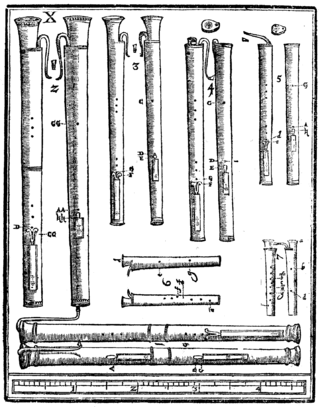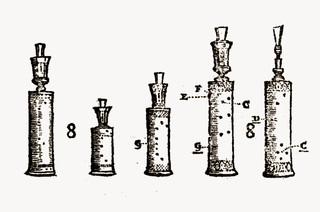
Bagpipes are a woodwind instrument using enclosed reeds fed from a constant reservoir of air in the form of a bag. The Great Highland bagpipes are well known, but people have played bagpipes for centuries throughout large parts of Europe, Northern Africa, Western Asia, around the Persian Gulf and northern parts of South Asia.

The oboe is a type of double-reed woodwind instrument. Oboes are usually made of wood, but may also be made of synthetic materials, such as plastic, resin, or hybrid composites.

Woodwind instruments are a family of musical instruments within the greater category of wind instruments. Common examples include flute, clarinet, oboe, bassoon, and saxophone. There are two main types of woodwind instruments: flutes and reed instruments. The main distinction between these instruments and other wind instruments is the way in which they produce sound. All woodwinds produce sound by splitting the air blown into them on a sharp edge, such as a reed or a fipple. Despite the name, a woodwind may be made of any material, not just wood. Common examples include brass, silver, cane, as well as other metals such as gold and platinum. The saxophone, for example, though made of brass, is considered a woodwind because it requires a reed to produce sound. Occasionally, woodwinds are made of earthen materials, especially ocarinas.

A reed is a thin strip of material that vibrates to produce a sound on a musical instrument. Most woodwind instrument reeds are made from Arundo donax or synthetic material. Tuned reeds are made of metal or synthetics. Musical instruments are classified according to the type and number of reeds.

The uilleann pipes are the characteristic national bagpipe of Ireland. Earlier known in English as "union pipes", their current name is a partial translation of the Irish language terms píobaí uilleann, from their method of inflation. There is no historical record of the name or use of the term uilleann pipes before the 20th century. It was an invention of Grattan Flood and the name stuck. People mistook the term 'union' to refer to the 1800 Act of Union; this is incorrect as Breandán Breathnach points out that a poem published in 1796 uses the term 'union'.

The crumhorn is a double reed instrument of the woodwind family, most commonly used during the Renaissance period. In modern times, particularly since the 1960s, there has been a revival of interest in early music, and crumhorns are being played again. It was also spelled krummhorn, krumhorn, krum horn, and cremorne.

The chanter is the part of the bagpipe upon which the player creates the melody. It consists of a number of finger-holes, and in its simpler forms looks similar to a recorder. On more elaborate bagpipes, such as the Northumbrian bagpipes or the Uilleann pipes, it also may have a number of keys, to increase the instrument's range and/or the number of keys it can play in. Like the rest of the bagpipe, they are often decorated with a variety of substances, including metal (silver/nickel/gold/brass), bone, ivory, or plastic mountings.

The shawm is a conical bore, double-reed woodwind instrument made in Europe from the 12th century to the present day. It achieved its peak of popularity during the medieval and Renaissance periods, after which it was gradually eclipsed by the oboe family of descendant instruments in classical music. It is likely to have come to Western Europe from the Eastern Mediterranean around the time of the Crusades. Double-reed instruments similar to the shawm were long present in Southern Europe and the East, for instance the ancient Greek, and later Byzantine, aulos, the Persian sorna, and the Armenian duduk.

The dulcian is a Renaissance woodwind instrument, with a double reed and a folded conical bore. Equivalent terms include English: curtal, German: Dulzian, French: douçaine, Dutch: dulciaan, Italian: dulciana, Spanish: bajón, and Portuguese: baixão.

The rackett, raggett, cervelas, or sausage bassoon is a Renaissance-era double reed wind instrument, introduced late in the sixteenth century and already superseded by bassoons at the end of the seventeenth century.

The bassanello was a Renaissance double reed woodwind instrument which was described in 1619 by Michael Praetorius in his Syntagma Musicum II:

In music, the bore of a wind instrument is its interior chamber. This defines a flow path through which air travels, which is set into vibration to produce sounds. The shape of the bore has a strong influence on the instrument's timbre.

The heckel-clarina, also known as clarina or patent clarina, is a very rare woodwind instrument, invented and manufactured by Wilhelm Heckel in Wiesbaden-Biebrich, Germany. Heckel received a patent for the instrument on 8 December 1889. It was apparently intended to be used for the shepherd’s pipe solo in Act III of Wagner's Tristan und Isolde. It was used beginning in 1891 at the Festspielhaus, Bayreuth as a substitute for Wagner's Holztrompete; the clarina was found more practical and more effective in producing the desired tone-colour.

The hornpipe can refer to a specific instrument or a class of woodwind instruments consisting of a single reed, a large diameter melody pipe with finger holes and a bell traditionally made from animal horn. Additionally, a reed cap of animal horn may be placed around the reed to contain the breath and allow circular breathing for constant play, although in many cases the reed is placed directly in the mouth. It was also known as the pibcorn, pibgorn, or piccorn. One rare Scottish example, called the stock-and-horn, is referred to by Robert Burns among others. Other hornpipes include the Spanish gaita gastoreña, the Basque alboka and the Eastern European zhaleika. When joined with a bag, Baines refers to the instruments as "bag-hornpipes".

Moeck Musikinstrumente + Verlag is a leading German manufacturer of recorders and a music publisher.
Reed aerophones is one of the categories of musical instruments found in the Hornbostel-Sachs system of musical instrument classification. In order to produce sound with these Aerophones the player's breath is directed against a lamella or pair of lamellae which periodically interrupt the airflow and cause the air to be set in motion.

The term „Marktsackpfeife“ commonly refers to a type of bagpipe which has been developed in East Germany at the beginning of 1980s for the specific purpose to be played at faires and markets as a modern interpretation of a certain type of Medieval bapipes. Depictions of such bagpipes are found in Medieval sources and are characterized by specific features like wide flaring bells atop the chanter and drones, apparent conical shape of the chanter and reportedly substantial volume of their sound. Since no actual chanters of this type of bagpipe have survived and/or have been recovered so far, the MSP has to be classified as a purely modern musical instrument having a historically informed exterior. MSP chanters typically use double reeds made of plastic or Arundo donax cane and drones usually work with single reeds made of same materials. Chanter bores are conical with a pronounced flare at the end as they transition into the bell.


















